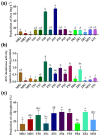Role of Two Plant Growth-Promoting Bacteria in Remediating Cadmium-Contaminated Soil Combined with Miscanthus floridulus (Lab.)
- PMID: 34063227
- PMCID: PMC8147505
- DOI: 10.3390/plants10050912
Role of Two Plant Growth-Promoting Bacteria in Remediating Cadmium-Contaminated Soil Combined with Miscanthus floridulus (Lab.)
Abstract
Miscanthus spp. are energy plants and excellent candidates for phytoremediation approaches of metal(loid)s-contaminated soils, especially when combined with plant growth-promoting bacteria. Forty-one bacterial strains were isolated from the rhizosphere soils and roots tissue of five dominant plants (Artemisia argyi Levl., Gladiolus gandavensis Vaniot Houtt, Boehmeria nivea L., Veronica didyma Tenore, and Miscanthus floridulus Lab.) colonizing a cadmium (Cd)-contaminated mining area (Huayuan, Hunan, China). We subsequently tested their plant growth-promoting (PGP) traits (e.g., production of indole-3-acetic acid, siderophore, and 1-aminocyclopropane-1-carboxylate deaminase) and Cd tolerance. Among bacteria, two strains, Klebsiella michiganensis TS8 and Lelliottia jeotgali MR2, presented higher Cd tolerance and showed the best results regarding in vitro growth-promoting traits. In the subsequent pot experiments using soil spiked with 10 mg Cd·kg-1, we investigated the effects of TS8 and MR2 strains on soil Cd phytoremediation when combined with M. floridulus (Lab.). After sixty days of planting M. floridulus (Lab.), we found that TS8 increased plant height by 39.9%, dry weight of leaves by 99.1%, and the total Cd in the rhizosphere soil was reduced by 49.2%. Although MR2 had no significant effects on the efficiency of phytoremediation, it significantly enhanced the Cd translocation from the root to the aboveground tissues (translocation factor > 1). The combination of K. michiganensis TS8 and M. floridulus (Lab.) may be an effective method to remediate Cd-contaminated soils, while the inoculation of L. jeotgali MR2 may be used to enhance the phytoextraction potential of M. floridulus.
Keywords: Miscanthus floridulus (Lab.); bioinoculation; metal(loid)s; phytoremediation.
Conflict of interest statement
The authors declare no conflict of interest.
Figures






Similar articles
-
Heteroauxin-producing bacteria enhance the plant growth and lead uptake of Miscanthus floridulus (Lab.).Int J Phytoremediation. 2022;24(11):1205-1212. doi: 10.1080/15226514.2021.2024134. Epub 2022 Jan 7. Int J Phytoremediation. 2022. PMID: 34995152
-
Two microbes assisting Miscanthus floridulus in remediating multi-metal(loid)s-contaminated soil.Environ Sci Pollut Res Int. 2024 Apr;31(20):28922-28938. doi: 10.1007/s11356-024-33032-3. Epub 2024 Apr 2. Environ Sci Pollut Res Int. 2024. PMID: 38565816
-
[Effects of plant growth-promoting rhizobacteria Klebsiella michiganensis TS8 and Lelliottia jeotgali MR2 on the growth and cadmium uptake of Arabidopsis thaliana under cadmium stress].Sheng Wu Gong Cheng Xue Bao. 2022 May 25;38(5):1915-1928. doi: 10.13345/j.cjb.210682. Sheng Wu Gong Cheng Xue Bao. 2022. PMID: 35611738 Chinese.
-
Promises and potential of in situ nano-phytoremediation strategy to mycorrhizo-remediate heavy metal contaminated soils using non-food bioenergy crops (Vetiver zizinoides & Cannabis sativa).Int J Phytoremediation. 2020;22(9):900-915. doi: 10.1080/15226514.2020.1774504. Epub 2020 Jun 13. Int J Phytoremediation. 2020. PMID: 32538143 Review.
-
Advances in the application of plant growth-promoting rhizobacteria in phytoremediation of heavy metals.Rev Environ Contam Toxicol. 2013;223:33-52. doi: 10.1007/978-1-4614-5577-6_2. Rev Environ Contam Toxicol. 2013. PMID: 23149811 Review.
Cited by
-
The Marine-Origin Exopolysaccharide-Producing Bacteria Micrococcus Antarcticus HZ Inhibits Pb Uptake in Pakchoi (Brassica chinensis L.) and Affects Rhizosphere Microbial Communities.Microorganisms. 2024 Oct 1;12(10):2002. doi: 10.3390/microorganisms12102002. Microorganisms. 2024. PMID: 39458311 Free PMC article.
-
Exploring the impact of plant growth-promoting bacteria in alleviating stress on Aptenia cordifolia subjected to irrigation with recycled water in multifunctional external green walls.BMC Plant Biol. 2024 Aug 24;24(1):802. doi: 10.1186/s12870-024-05511-9. BMC Plant Biol. 2024. PMID: 39179975 Free PMC article.
-
Bacteria associated with Zn-hyperaccumulators Arabidopsis halleri and Arabidopsis arenosa from Zn-Pb-Cd waste heaps in Poland as promising tools for bioremediation.Sci Rep. 2023 Aug 3;13(1):12606. doi: 10.1038/s41598-023-39852-6. Sci Rep. 2023. PMID: 37537323 Free PMC article.
-
Physiological and transcriptomic analyses reveal the cadmium tolerance mechanism of Miscanthus lutarioriparia.PLoS One. 2024 May 15;19(5):e0302940. doi: 10.1371/journal.pone.0302940. eCollection 2024. PLoS One. 2024. PMID: 38748679 Free PMC article.
-
Use of plant growth-promoting bacteria to facilitate phytoremediation.AIMS Microbiol. 2024 Jun 12;10(2):415-448. doi: 10.3934/microbiol.2024021. eCollection 2024. AIMS Microbiol. 2024. PMID: 38919713 Free PMC article. Review.
References
-
- Ebbs S.D., Lasat M.M., Brady D.J., Cornish J., Gordon R., Kochian L.V. Phytoextraction of cadmium and zinc from a contaminated soil. J. Environ. Qual. 1997;26 doi: 10.2134/jeq1997.00472425002600050032x. - DOI
Grants and funding
- 41807135/National Natural Science Foundation of China
- 41877491/National Natural Science Foundation of China
- 31800076/National Natural Science Foundation of China
- 2019JJ50220/Natural Science Foundation of Hunan Province
- 18B107/the Scientific Research Fund of Hunan Provincial Education Department
- 2018WK4025/Hunan Provincial Science and Technology Department
- 2020NK2004/Hunan Provincial Science and Technology Department
- 2020ZL2004/Hunan Provincial Science and Technology Department
- SYL201802003/Double first-class construction project of Hunan Agricultural University
- YB2018007/Double first-class construction project of Hunan Agricultural University
- CX20190497/Double first-class construction project of Hunan Agricultural University
LinkOut - more resources
Full Text Sources
Miscellaneous

